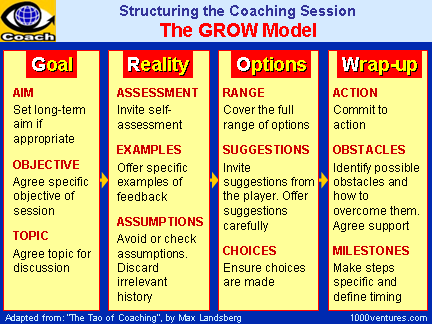| |
|
How to structure a coaching
session
GROW Model
Goal – Reality – Options –
Wrap-up
|
|
|
 |
|
The GROW (Goal, Reality, Options,
Wrap-up) model is one of the most common coaching tools. The
framework provides a simple four-step structure for a coaching
session that enables the coach to structure a coaching conversation
and deliver a meaningful result. |
|
| |
The discussion should start with
defining the topic in order to
understand what specifically the
player wants to talk about, what
territory you are in, the scale
of the problem, the importance
and emotional significance of
the topic to the player and the
player’s long-term vision of
goal for the topic.
|
|
Coaching
Coaching
Defined
Basic
Components
5 Myths
about Coaching |
|
|
|
Adapted from
The Tao of Coaching,
Max Landsberg
"Nothing is more
terrible than ignorance in action." ~ Johann Wolfgan von
Goethe
|
Tips
for Using the GROW
Model |
-
Use more 'ask'
than 'tell'; elicit
innovative ideas from your player – don't just try to show you are
smart
-
Think creatively – not just
systematically, invite
radical
ideas, particularly in the Options and Wrap-up steps
-
Illustrate, and check understanding, throughout by using
specific examples – from your own and the player's experiences
-
In the wrap-up stage, get the player to
say exactly what the action plan is.
|
|
A Simple Four-Step
Structure
→
Problem Solving Strategies:
4 Levels
→
Turn Problems to Opportunities:
6 Tips
Step 2: Reality.
Both coach and player invite self-assessment and offer specific
examples to illustrate their points and achieve the most accurate
picture of the topic possible.
Step 3: Options.
In the options stage the coach’s intention is to draw out a list
of what all that is possible for the player to do without judgment
and evaluation. Coach elicits suggestions from the player by
asking effective questions and guides him/her towards making the
right choices.
Step 4: Wrap-up.
In this stage the coach’s intention is to gain
commitment to action. Coach and player select the most
appropriate options, commit to
action,
define the action plan, the next steps and a timeframe for their
objectives and identify how to overcome obstacles.
|
|
|